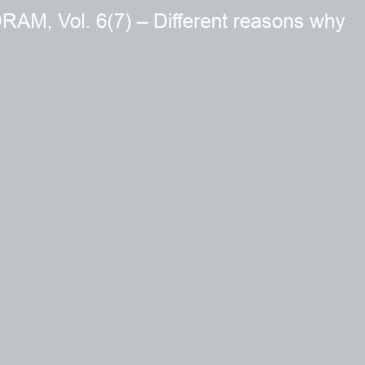Previous studies have demonstrated a positive association between maltreatment during childhood and drinking-related problems later in life (Bensley, Spieker, Van Eenywk, & Schoder, 1999). However, the motivational mechanisms underlying this association have not been studied. This week DRAM reviews a paper that examines why men and women who report experiencing childhood maltreatment abuse alcohol (Goldstein, Flett, & Wekerle, 2010).
Method
- Eighty-six male and 132 female college students answered questions regarding
- Childhood maltreatment (i.e., physical, sexual and emotional abuse; physical and emotional neglect), assessed with the 28-item Childhood Trauma Questionnaire (CTQ; Bernstein and Fink, 1998).
- Drinking motives, assessed with the 28-item Modified Drinking Motives Questionnaire-Revised (M-DMQ-R; Grant et al., 2007)o Alcohol consumption and consequences, assessed with the Alcohol Use Disorders Identification Test (AUDIT; Saunders, Aasland, Babor, De La Fuente, & Grant, 2006).
- The researchers built models separately for men and women to examine which drinking motives mediate the effect of childhood maltreatment on alcohol problems.
Results
- Approximately half (51.6%) of the male students and 23.4% of the female students were binge drinking at least monthly.
- Overall, 31% of students reported experiencing any type of abuse and 30% reported any type of neglect
- There was a positive association between being abused (r = .32, p < .01) or neglected (r = .28, p <.05) and having alcohol problems.
- For men, the association between being maltreated (e.g., neglected or abused) and having alcohol problems was mediated by the motive “to feel good and get happy;” this model accounted for 42.12% of the variance in alcohol problems, adjusted R2 =0.39.
- For women, this association was mediated by the desire to cope with depression and anxiety (this model accounted for 22.54% of the variance in alcohol problems (adjusted R2 = .21).
| Coping-anxiety motive | Coping-depression motive | Enhancement motive | Total model | |
| Men | 1.15 | .31 | 2.01* | 2.48* |
| Women | -.95 | 2.56** | 2.02* | 3.15** |
Figure. Mediation effects (Z values) of drinking motives on childhood maltreatment to alcohol problems association for both genders. * p < .05; ** p < .01. Click image to enlarge.
Limitations
- Retrospective reports might reflect some memory bias. For example, individuals who have drinking problems might be inclined to recall more childhood maltreatment.
- Correlational design prevents causality interpretation.
- Convenience sample (i.e., students) decreases generalizability of the results to other populations.
Conclusion
Men who report experiencing maltreatment during their childhood tend to report drinking to feel good and to get happy. In other words, the enhancement motive mediates the association between childhood maltreatment and alcohol problems among men. For women who were maltreated, problematic drinking is associated with a desire to cope with depression and anxiety. In other words, coping with depression and anxiety mediates the association between problematic drinking and childhood maltreatment among women. Further studies will need to conduct longitudinal studies to establish causality (i.e. to examine if childhood maltreatment indeed leads to future alcohol-related problems).
— Julia Braverman
What do you think? Please use the comment link below to provide feedback on this article.
References
Bensley, S. L., Spieker, S. J., Van Eenwyk, J., & Schoder, J. (1999). Self-reported abuse history and adolescent problem behaviours. II. Alcohol and drug use. Journal of Adolescent Health, 24, 173-180.
Bernstein, D. P., & Fink, L. (1998). Childhood Trauma Questionnaire: A retrospective self-report manual. San Antonio, TX: The Psychological Corporation.
Goldstein, A. L., Flett, G. L., & Wekerle, C. (2010). Child maltreatment, alcohol use and drinking consequences among male and female college students: An examination of drinking motives as mediators. Addictive Behaviors, 35(6), 636-639.
Grant, V. V., Stewart, S. H., O’Connor, R. M., Blackwell, E., & Conrod, P. J. (2007).Psychometric evaluation of the five-factor Modified Drinking Motives Questionnaire—Revised in undergraduates. Addictive Behaviors, 32, 2611-2632.
Saunders, J. B., Aasland, O. G., Babor, T. F., De La Fuente, J. R., & Grant, M. (2006).Development of the Alcohol Use Disorders Identification Test (AUDIT): WHO Collaborative project on early detection of persons with harmful alcohol consumption-II. Addiction, 88, 791-804.





Joe Rinehart, LMHC September 1, 2010
Could not “drinking to feel good and get happy” be interpreted to be the same as drinking to “cope with depression and anxiety?”
Addiction/Recovery Researcher September 7, 2010
One additional point: Could it be that the “motivators” of males and females in this study are really not so different (perhaps not different at all), but instead that the “differences” between groups are largely an artifact of gender-related LINGUISTIC differences?
It has grown to be almost stereotypical that men and women differ in their orientation toward affect-laden/emotional language, as well as experiencing/expressing “feelings” in general . Perhaps the “feel good/get happy” male finding is just the male/”be strong” version of “alleviate depression and anxiety.” (Or to be absolutely fair, the female “alleviate depression/anxiety” is the more female/emotion-acknowledging version of “feel good/get happy”!)
If the authors had a way of accounting for such influences on their data, it was not apparent in this BASIS article. If NOT, perhaps that should be examined.
BASIS staff September 9, 2010
Thank you for your comment. It may be a good point to examine indeed.